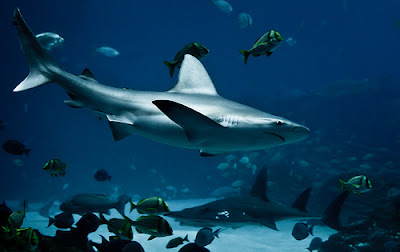Animal Unique | Sandbar Shark | The Sandbar shark is a kind of requiem shark, family Carcharhinidae. The Sandbar shark is also called Thick skin shark or Brown shark. It is one of the largest coastal sharks in the world, and is closely related to the Dusky shark, Bignose shark and ull shark. It is very common along the coast of the Mid-Atlantic states, sand banks to expand into the western Atlantic from southern Massachusetts to southern Brazil. In the eastern Pacific, which occur around the Hawaiian, Galapagos, and Revillagigedo Islands. The Sandbar shark, true to its nickname, is often found on muddy or sandy bottoms in shallow coastal waters such as bays, estuaries, harbors, or the mouths of the rivers, but also swim in deeper waters.
Scientific classification
Kingdom: Animalia
Phylum: Chordata
Class: Chondrichthyes
Subclass: Elasmobranchii
Order: Carcharhiniformes
Genus: Carcharhinus
Species: C. plumbeus
Kingdom: Animalia
Phylum: Chordata
Class: Chondrichthyes
Subclass: Elasmobranchii
Order: Carcharhiniformes
Genus: Carcharhinus
Species: C. plumbeus
Sandbar sharks are stout shark with a moderately long, rounded snout, and a high, triangular, saw tooth edges above. This species has a interdorsal cam and a strikingly large first dorsal fin. Sandbar sharks are blue-gray or brown to bronze in color on the back and flanks and white on the belly. The tips and outer margins of their fins are sometimes darker than the rest of their bodies. Sandbar sharks usually have heavy-set bodies and rounded snout that are shorter than the average shark's snout. Their upper teeth have broadly uneven cusps with sharp edges. The second dorsal and anal fins are near the same height. His body color can vary from a bluish to brownish gray with a bronze, with a white or pale underside. Sandbar sharks swim alone or in sex-segregated schools that vary in size.
Sandbar sharks are opportunistic feeders that prey on bottom bony fishes, small sharks, rays, cephalopods, gastropods, crabs and shrimp. Sandbar sharkss feed during the day, but more and more active at night. Natural enemies are the tiger sharks and great whites rarely. Sandbar shark and Dusky sharks are coastal migrants who have taken a particularly hard hit by longline fishing for both their meat and their fins. Sandbar sharks are generally called brown by fishermen along the East Coast of the United States, where they often migrate in large bays to spawn. Although in principle the ground sharks, they are extremely strong fighters. The twilight is almost indistinguishable from the Sandbar shark, but grows to more than 700 pounds, the sandbar never exceeded more than 200 pounds.
Sandbar sharks are viviparous. The embryos are supported in the yolk sac placenta in the mother. The female has a three year reproductive cycle and give birth to an average of 8 puppies. They carry the young for one year before birth. In the northern hemisphere, mating takes place in spring or early summer (May-June). Sandbar sharks in the Southern Hemisphere partner during the warmer summer months between late October to January. The mating begins when a man follows a woman, occasionally biting them between the dorsal fins until they give him access to a branch to insert into the cloaca. As with other shark species, women are often seen with permanent scars as a result of this mating ritual.
Sandbar sharks are considered harmless to humans. There are very few cases of sandbar sharks make unprovoked attacks on humans. You should always use caution to protect yourself against sharks and other marine creatures when swimming or wading. This species has slowly grown and has a low reproduction and is therefore particularly vulnerable to threats such as commercial hunting and the subsequent overfishing. The Chesapeake Bay is one of the most important Sandbar shark nursery areas on the east coast.
Animal Unique




